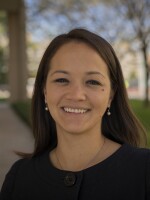This is part of Essential Voices, a series of interviews with people confronting COVID-19.
Since the start of the COVID-19 outbreak, local public health agencies across the nation have been working to mitigate the spread of the disease -- and to overcome some big obstacles.
Public health staffers work with health care providers to monitor those with COVID-19 symptoms who have been placed in isolation, whether in the hospital or at home. They also identify, notify and monitor people who may have been exposed to COVID-19—a process known as contact tracing.
Julie Pryde, administrator of the Champaign-Urbana Public Health District in central Illinois, says even with plans in place, her agency and local health care providers are running into problems they did not anticipate.
“What I don’t think any of us took into account was what we’re seeing now with the lack of resources,” Pryde says. “So even if you happen to be a place that has a lot of money… you just can’t go out and buy these items that are needed: personal protective equipment, ventilators, testing supplies.
“So, this is a whole different level of frustration than I’ve experienced before. And it’s not just here it is, it’s across the entire country.”
Despite the unexpected challenges, Pryde says, the agency has continued to conduct contact tracing. And as the number of COVID-19 cases in her county has risen, so has the workload.
Hear more personal stories on COVID-19 from the America Amplified initiative
To adjust, Pryde's agency has shifted staff from certain areas—such as dental, infectious disease or maternal and child health—to work on contact tracing and staffing a hotline seven days a week.
It has been manageable, she says, but also frustrating. The ongoing shortage of COVID-19 testing materials leads to delays and forces public health officials to limit testing to those who meet certain criteria set by the federal Centers for Disease Control and Prevention and the state’s department of public health.
“Unfortunately we have to prioritize with what we have,” Pryde says. “We’re still, as a country, not there, and we’re not getting the support that’s needed to do the testing.”
Commercial labs have backlogs that cause delays on results, Pryde says.
To help with the backlog—and prevent state public health labs from being overwhelmed—Carle Foundation Hospital in Urbana and the University of Illinois at Urbana-Champaign worked together to launch on-site testing in late March. They coordinate with other area health care providers to analyze samples collected from patients throughout Champaign County.
That has helped speed the process, but Pryde says limited testing materials prevent them from expanding criteria to test more people.
Supply shortages have created challenges for public health departments at both the state and local level, Pryde says.
“It’s turned into a ridiculous almost, like, cage match of people trying to compete with each other for resources. That is not how this should be happening,” she says.
Instead, Pryde says supplies would ideally be sourced by the federal government, manufactured on a large scale and distributed based on a plan, depending on either population or hot spots.
“It shouldn’t be that local [agencies], states, cities are competing with each other trying to get the same resources and then inadvertently raising the price of them up,” she says.
Like many public health officials, Pryde wants the public to understand that the goal of continuing to practice social distancing is to keep the number of COVID-19 cases low enough, and spread out long enough, to prevent the healthcare system from getting overwhelmed.
“So far, so good on that” in Champaign County, Pryde says. “I just knocked on wood.”
Since this interview was recorded, testing capacity has grown to allow anyone with COVID-19 symptoms to get a test.
Christine Herman is a reporter at Illinois Public Media. Follow her on Twitter: @CTHerman
This story was produced by Side Effects Public Media, a news collaborative covering public health.
Side Effects, WFYI and Indiana Public Broadcasting are asking Americans about health issues, as part of America Amplified: Election 2020. The public media initiative, funded by the Corporation for Public Broadcasting, uses community engagement to inform and strengthen local, regional and national journalism. Follow on Twitter at @amplified2020.
If you have a personal story to share from the front lines of this pandemic, wherever that may be, email health@wfyi.org.






